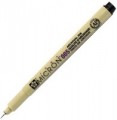—
Ballpoint. The most popular type of pens nowadays. The name is due to the fact that the basis of the writing mechanism in such pens is a special ball the size of a fraction of a millimetre: it is wetted with pasty ink and, rolling along the paper, leaves a trace. Ballpoint pens are simple, reliable and at the same time inexpensive, have a fairly long service life, and their ink does not smudge even on “loose” paper. On the other hand, writing such a pen requires more effort than a fountain or gel pen; this may degrade the quality of the handwriting. In addition, the ball mechanism does not work on almost any surface other than paper, and such a pen quickly stops writing on a horizontal surface (however, the exception to both cases are “space” models, see “Features”).
—
Gel. A variation of the ballpoint pens described above that uses gel-like ink. Also, such models differ somewhat in the design of the writing unit, due to which they require less effort for writing. This provides additional convenience and can even improve the quality of handwriting (sometimes poor handwriting is associated precisely with the less convenient ballpoint pens). In addition, gel ink is suitable not only for paper, but also for many other types of surface. Among the cons of this option, there are a slightly longer ink drying time than for ballpoint pens, a rather high rate of their consumption, as well as a tendency to “
...spread” on loose paper.
Also note that the gel in our catalog also includes the so-called rollerball pens: they use an improved writing mechanism, water-based ink (as in fountain pens), somewhat more convenient than classic gel pens, but otherwise completely similar.
— Fountain. The oldest type of pen produced today. They have a writing part in the form of a metal "feather" with a narrow channel in the middle; through this channel, the ink comes from the reservoir built into the pen to the tip of the pen. For refueling, both special pumps (in more expensive models) and replaceable capsules (in entry-level models) can be used. Anyway, one of the practical advantages of this design is the minimal resistance when moving across the paper (this makes fountain pens, in particular, perfect for initial write learning). On the other hand, even the simplest of these devices are much more expensive than ball and gel models. Therefore, nowadays, most fountain pens are fashion accessories, designed not so much for everyday use, but to emphasize the status of the owner. The pen in such models can be made of expensive metals, such as gold or platinum. However, there are also the contrary models — relatively simple and inexpensive fountain pens for everyday use.
— Multifunction. Models that have one or another additional “writing” function, in addition to the pen itself. Most multifunctional models combine a pen and pencil (see "Features"), but there are other options — for example, a pen with a marker on the opposite side from the writing nib.
— Technical pen. A special kind of pen that works on the capillary principle: ink is supplied from a container through a rod with many microscopic channels. Felt-tip pens work on a similar principle; liners differ from them in a relatively small line thickness. However, this thickness can be different; and in some models, the nib has a beveled shape (similar to some paint brushes), which allows it to be used for both thin and wide strokes. Anyway, the technical pens are intended more for drawing than for writing: they are convenient for sketching, drawing the outlines, etc. However, nothing prevents using such a device when writing, especially since the technical pens does not require much effort when moving on paper.The colour of the ink originally supplied with the pen, in other words, the colour that the pen writes out of the box, without replacing the refill/cartridge or refilling the ink.
Blue is traditionally used for writing,
black is somewhat less common, and
red ink is convenient for making corrections. Nevertheless, in addition to these colours, there are others, including rather unusual ones:
green,
yellow,
orange,
pink, etc. Keep in mind that other colours can be changed within most modern pens.
